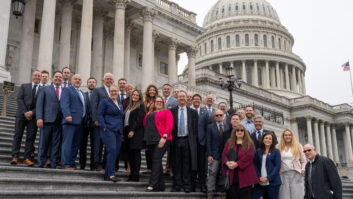by Jeremy J. Glowacki
It’s not easy being a trade association in an era of mass media overload, social networking chatter, and instant-answer internet. But as I found out from a conversation with CEDIA CEO Utz Baldwin the other day, CEDIA is well on its way to reworking the entire notion of how a trade association should be organized for the future.
My interview of Baldwin was a follow-up to a message CEDIA leadership sent to CEDIA members telling them their membership rules would be changing in 2012, with less emphasis being placed on mandatory certification. Beginning next year, CEDIA will eliminate membership levels (provisional vs. full). All CEDIA electronic systems contractors (ESC) members will pay the same membership fee and all ESC members will have access to the CEDIA logo in addition to being listed on the Electronic Lifestyles Finder Service, among many other CEDIA member benefits. It’s not that certification programs weren’t valued, but rather they became a casualty of resource allocation challenges, the association contends. Therefore, CEDIA will now offer certain incentives to CEDIA-Certified members to reward those who still value the process. CEDIA ESC member companies who employ a CEDIA-Certified professional will enjoy a premium listing within the CEDIA Electronic Lifestyles Finder Service as well as one year of free access to CEDIA research reports.
Other new benefits available to all CEDIA members include a discounted CEDIA Sales Assessment Tool from Richard James & Partners to help companies determine whether a potential employee will perform well in their sales environment. This tool normally costs companies $300, but the CEDIA member version is available for $99.

Another benefit to CEDIA members is a 15-percent discount on Paychex services, including payroll, tax filing, Flexible Spending Accounts, and 401k. Additionally, CEDIA will offer CEDIA-Certified members with up to 23 percent off (and no set-up fee) for the MicroBilt service, which offers small business owners simple, cost-effective solutions, and a wide selection of data products for fraud prevention, consumer financing, debt collection, and background screening.
Finally, CEDIA will reward its members with its ESC Marketing On-Demand program, which features brochures, postcards, and other promotional materials that members can customize and print at affordable rates. These professionally designed pieces feature stunning photography and industry-specific messaging that has been developed to communicate to homeowners, architects, builders, and interior designers the importance of partnering with a qualified electronic systems professional.
CEDIA’s new approach to rewarding, instead of mandating CEDIA Certification is just one part of a whole new strategic plan championed by Baldwin and ratified earlier this month by the CEDIA board of directors, which looks to how associations like CEDIA need to rethink everything that they do to serve their members. For one thing, CEDIA, which was founded by electronic systems contractors for electronic systems contractors (when they were actually called “installers”), is beginning to realize to value in extending its support to “all stakeholders,” as Baldwin calls them, including manufacturers, reps, distributors, the media, as well as the ESC.
“Our mission is still dead on in support of and to represent the independent electronic systems contractor,” Baldwin explained, “but if all of our effort is spent solely on the needs of the ESC, there’s a disconnect then between how the ESC should interface with the manufacturer and vice versa or the role of the sales rep. The definition of an association is an organization of people with a common interest. And our industry is the common interest of the ESC, the manufacturer, the sales rep, the media, architects, designers, and builders, and even the consumers. So by making sure that we engage manufacturers and the press and sales reps and distributors, it will provide better opportunities for CEDIA to serve the market and ultimately fulfill our vision and mission and that’s to add value and be a core component of our members’ prosperity.”
CEDIA’s “products and services” will continue to be created solely for use by the its core member, the ESC, but the association is going to engage other stakeholders and find ways to bridge the relationship, promote commerce, and raise the awareness of the industry, Baldwin said. Proof of that belief in reaching out to other stakeholders, he pointed out, was electing a manufacturer, Triad’s Larry Pexton, as an officer to the CEDIA board. “That demonstrates that manufacturers do have valuable input, and the manufacturers that serve our industry only have the ESC’s best interest in mind,” Baldwin said. “If the ESC succeeds, manufacturers get more purchase orders, and they succeed.”

CEDIA CEO Utz Baldwin addressing guests at the 2010 Electronic Lifestyles Awards banquet.
Underlying every initiative described by Baldwin seemed to be CEDIA’s goal of creating a better environment for industry stakeholders to make money, essentially. And at no time did he give the impression that our industry is in dire straits due the economy or changing market dynamics. Rather, he pointed out the abundant opportunities that exist, if handled the right way by the industry and CEDIA.
“There’s no question that the industry is changing and there are many external forces that are driving that change,” Baldwin stated. “Clearly more consumers are interested in the solutions that our industry provides, regardless of level. There’s affluent down to the mass market and do it yourselfers. But clearly there are more consumers interested in it and that’s only going to increase because of the second external force, which is simply that there are more influencers in front of the consumer today promoting the benefits of the technology.”
Baldwin described these external influencers as “everyone from mass merchants to manufacturers,” like Apple, which ran a commercial many months ago for the app designed to control your lights. “Millions of people saw that advertisement and realized that you can turn your lights on or off from your car or when you’re out of town,” Baldwin explained. “This is a great opportunity for our industry, but the risk with that and with all of these influencers out there is the disconnect from the consumer who does not realize what goes on behind the solution. Many consumers think, ‘Well I only need to download this app and I get lighting control.’ No, there’s hardware required behind that app and expertise that’s required behind that app.”
Baldwin cited other influencers like Comcast, ADT, and Verizon, to name just few, that are all making announcements to consumers about home control, connectivity, and mobile applications as well as other trends such as the “exponential” speed of product commoditization and even “internal influencers or stakeholders,” such as security professionals and electricians that have entered this space and need to be addressed.
“We have to rethink how our association needs to prepare members for the future,” Baldwin said. “The association has been working very very hard not simply to react to these external forces and the change that our industry is facing, but to position CEDIA to lead our industry into the future.”
So getting back to those new CEDIA membership rules, a very brief history lesson is important. In the absence of consistent licensing requirements from states or the federal government, up until now CEDIA had believed that creating a barrier to entry to the industry was a way to protect the industry and protect the consumer from shoddy workmanship. That’s what led to the creation of two different classes of membership. It made sure that if you weren’t certified, you couldn’t misrepresent yourself as a “qualified” installer. Eventually, however, the attrition of industry members due to economic decline combined with a push back from members that protested the added costs of CEDIA membership, forced to respond.
It’s About Influence, Not Dollars
Baldwin told me that CEDIA’s concerns about waning membership numbers are about influence, rather than revenue. “To lead the industry into the future, first and foremost as an association we have to have membership; we have to represent tax dollars and votes in order for the association to advocate the needs of the electronic systems contractor in front of lawmakers,” he explained.
Legislative advocacy is not new for CEDIA. The association has fought to protect the industry from potentially harmful laws time and time again in places like New York, Massachusetts, Texas, and California, protecting the interests of all electronic systems contractors, not just CEDIA members.
By making certification easier to attain, Baldwin noted, perhaps more businesses will be able to allocate resources to it, the association’s lobbying power will increase further, and the industry’s workforce will be better positioned to supply the ensuing demand for new technology integration. “If we do not build a skilled workforce as an association, there will simply be an unskilled workforce out there installing technology into the home, and nobody wins if it’s not installed properly. We realize that there are companies out there that need the education and if they’re going to be in the industry, we need to be inviting them and bring them in and make sure they perform the level of service that we want our industry to represent.”
More Visibility
Another goal of CEDIA’s strategic plan is to position the association to better influence consumers, industry partners (architects, designers, and builders), manufacturers, and mainstream media that seek out CEDIA members and the solutions that the industry provides. “Although we’ve been doing that for years, it’s taking a new approach to these types of initiatives,” Baldwin said. “We’ve been involved in outreach for at least 10 years, educating architects, builders, and designers of the technology we provide, the design considerations, how to work with an electronic systems contractor, but we want to take that from our work on a national level (with AIA, ASID, and NAHB) to a more a grassroots approach, where the association is shifting its focus to work closer with local chapters, promoting local events, as an extension of our members’ business development team to help generate activities in local markets.”
Baldwin said that in a perfect world, he would walk into a different CEDIA member’s office every Friday morning with a bag of donuts and some education or business tools. CEDIA, however, does not have the resources to do that right now, but can get to the next closest step by working with partners to create more local and regional events and getting the products and services that it has out to its members.
CEDIA will make more announcements throughout the year about specific tools, programs, and products that it will offering incentives to membership and more value to current members. It’s all part of the new plan to change with the times.
“CEDIA’s reinventing itself and not simply for CEDIA, but for how an association should behave,” Baldwin concluded. “Times are different. It’s simply that associations can no longer function the way they did in the past. Legacy behavior will not produce growth, will not serve the market, will not generate critical mass. We have served the market, create real tangible benefits for membership and if we do, members will come. If there’s a value proposition, we will grow membership.”
Baldwin encourages members of the industry to share their ideas or opinions with him by calling his mobile phone at 832.455.3930 or emailing [email protected].







